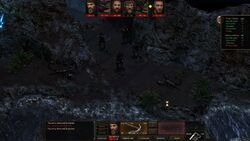RPG Codex Preview: A peek at Legends of Eisenwald
RPG Codex Preview: A peek at Legends of Eisenwald
Preview - posted by Zed on Sun 9 December 2012, 20:02:56
Tags: Alexander Dergay; Aterdux Entertainment; Legends of EisenwaldLegends of Eisenwald, the turn-based strategy/RPG influenced by the original King's Bounty and Disciples 2, was one of the earlier success stories of Kickstarter that we covered here at RPG Codex. A little while back, we were given a closed beta copy to preview the game for our readers, so I snatched it and did just that.
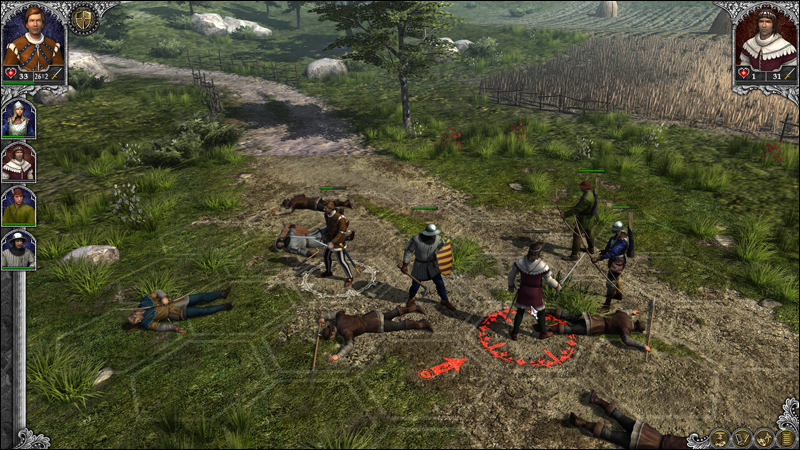
Here's a lil' bit from the preview:
Besides the actual preview, I also asked Aterdux' head Alexander Dergay a few questions regarding their experience with using Kickstarter:
There's more in the preview!
Read the full article: RPG Codex Preview: A peek at Legends of Eisenwald

Here's a lil' bit from the preview:
Besides castles and towns, you'll come across taverns, mills, graveyards, bandit hideouts, smithys and more. However, these locations don't always offer anything of interest. In fact, some locations appear to be completely uneventful. Also, a tavern could for instance at one point offer little more than gossip, and at another point (later in the scenario) offer a quest. This could very well be because its a beta, but perhaps many of the locations are meant to be little more than scenery.
You will also come across NPCs wandering the map. Although these NPCs are rarely more than guards and patrols, they help make the world feel a little more alive. While the writing may not be the game's strongest point, the gossip in taverns and the NPC interactions can be quite funny, albeit a little silly at times.
The combat of Eisenwald is initiative-driven and turn-based. This means that units will take their turns based on unit type and equipment. For instance, a ranged combatant will act faster using a longbow than a crossbow. Heavy armor also seems to burden the initiative of units. But, movement is not affected. This is because every single turn in Eisenwald requires an action. You can't choose to move somewhere specific and then end the turn without doing something. Instead, you must choose a target to attack, and your unit will automatically move there and do so. That is, unless the path is blocked by another unit. The only alternative is to skip the unit's turn entirely. This rather simple approach doesn't mean that there is no tactics involved, or that you can just click wherever and be victorious. In fact, combat feels very volatile in that any one unit may suddenly mess things up completely, and your initial positioning of units and how you use them will greatly affect the outcome.
You will also come across NPCs wandering the map. Although these NPCs are rarely more than guards and patrols, they help make the world feel a little more alive. While the writing may not be the game's strongest point, the gossip in taverns and the NPC interactions can be quite funny, albeit a little silly at times.
The combat of Eisenwald is initiative-driven and turn-based. This means that units will take their turns based on unit type and equipment. For instance, a ranged combatant will act faster using a longbow than a crossbow. Heavy armor also seems to burden the initiative of units. But, movement is not affected. This is because every single turn in Eisenwald requires an action. You can't choose to move somewhere specific and then end the turn without doing something. Instead, you must choose a target to attack, and your unit will automatically move there and do so. That is, unless the path is blocked by another unit. The only alternative is to skip the unit's turn entirely. This rather simple approach doesn't mean that there is no tactics involved, or that you can just click wherever and be victorious. In fact, combat feels very volatile in that any one unit may suddenly mess things up completely, and your initial positioning of units and how you use them will greatly affect the outcome.
Besides the actual preview, I also asked Aterdux' head Alexander Dergay a few questions regarding their experience with using Kickstarter:
Legends of Eisenwald, being an early adopter of the Kickstarter model, explored unknown territory with their campaign. When I asked Alexander Dergay how they prepared, he answered: “I think our success at Kickstarter was a combination of a lot of preparation and certainly a bit of luck.”
“Before our campaign on Kickstarter, we didn't know much about how it all worked and there was very little information available - no postmortems or other articles on how to do a campaign for a video game on Kickstarter.”
“Before our campaign on Kickstarter, we didn't know much about how it all worked and there was very little information available - no postmortems or other articles on how to do a campaign for a video game on Kickstarter.”
There's more in the preview!
Read the full article: RPG Codex Preview: A peek at Legends of Eisenwald
Aterdux' Alexander Dergay on crowdfunding via Kickstarter
Something interesting – nay, wonderful - happened back in March. It was like an oasis suddenly appeared in the barren lands of adventure games and traditional role-playing games. In a move that caused more than a small stir in the games industry, Tim Schaefer's Double Fine Adventure managed to raise over three million dollars via crowdfunding on Kickstarter. Shortly after that, Brian Fargo pretty much managed to repeat the feat with Wasteland 2, also raising over three millions (including PayPal donations – also thanks to RPG Codex, because we. are. the best.). Following these two crowdfunding successes, the year of 2012 has seen many industry veterans and developers of genre classics leap out of hiding for a chance to develop the games they have always really wanted to make... or to cash in on some easy money.
But not all of these early studio-based Kickstarter projects were looking to rake in millions of dollars. In fact, many of the more interesting games were very modest with their goals. This includes Legends of Eisenwald, a turn-based strategy-RPG currently being developed by the small Belarusian studio Aterdux Entertainment. Spearheaded by Alexander Dergay, this small outfit approached potential backers – donned in full medieval LARP clothing - and asked for $50,000 to aid the game's development. In the end they had managed to exceed their goal and landed on a not-too-shabby $83,577 (not counting PayPal and other donations).
Legends of Eisenwald, being an early adopter of the Kickstarter model, explored unknown territory with their campaign. When I asked Alexander Dergay how they prepared, he answered: “I think our success at Kickstarter was a combination of a lot of preparation and certainly a bit of luck.”
“Before our campaign on Kickstarter, we didn't know much about how it all worked and there was very little information available - no postmortems or other articles on how to do a campaign for a video game on Kickstarter.”
Like many other smaller studios, Aterdux had a hard time convincing publishers to work with them. “We talked to several publishers and the amount of material we had was not enough for them. It's understandable because we were a small and relatively unknown company.” Luckily for Aterdux, the backers of Kickstarter saw the potential of Eisenwald. “The material we had was enough to convince our backers at Kickstarter, and thanks to them we got funded and have now brought the game to the stage of beta testing.”
“The amount of material needed for a successful campaign is directly related to how well a company is known. A big and reputable name doesn't need to have a beta, or even an alpha version of the game. A well-prepared concept and just a little material is enough. But for lesser-known companies, more preparation work is needed.”
The effort Aterdux had to put into their Kickstarter campaign seems to have been worth it, though. Not only has their success given them exposure and funding for their game, but it may also have influenced business relations. “I have a suspicion that our investors were equally happy or relieved to see that they invested money in something other people liked, too.” Dergay says that Aterdux may look to crowdfunding again if they would face any troubles financing future games. But for now, they will stay busy working on Legends of Eisenwald.
A sneak peek at Eisenwald
After their successful crowdfunding campaign ending on the 22nd of May this year, the people at Aterdux have been busy as bees. The game was well on its way during the Kickstarter, having been in development for a couple of years already. It has now been running a closed beta for a few weeks. Granted, it's a very early closed beta with a few features missing, but it has the fundamental pieces in place and it's fully playable. This preview is based on a couple of play-throughs of the beta, which is about 2-3 hours long in total.
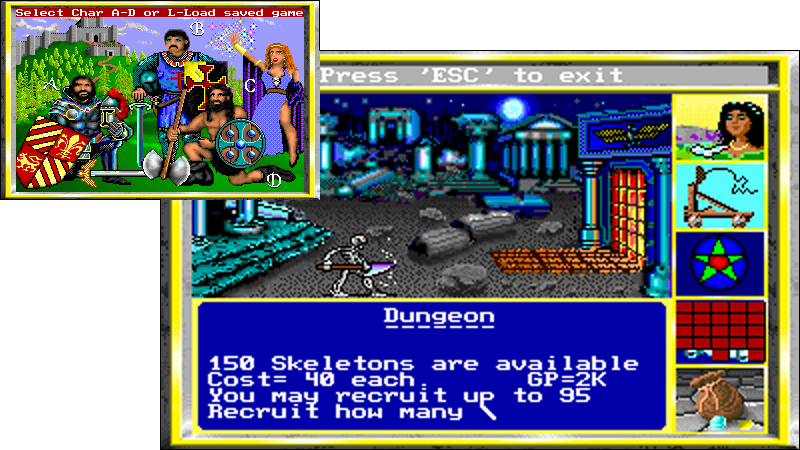
A very influential game: King's Bounty (1990)
So what exactly is Legends of Eisenwald? Well, it's a little challenging to describe. Vague comparisons could be drawn to games like Heroes of Might & Magic and the original King's Bounty because of how you traverse a “world map”, but the only fully comparable game would be the rather obscure Discord Times - Aterdux' earlier title from 2004 - which is very similar in concept but quite different in presentation and features. For instance, one of the big draws of Legends of Eisenwald is the 3D turn-based combat, something which in Discord Times wasn't nearly as elaborated.
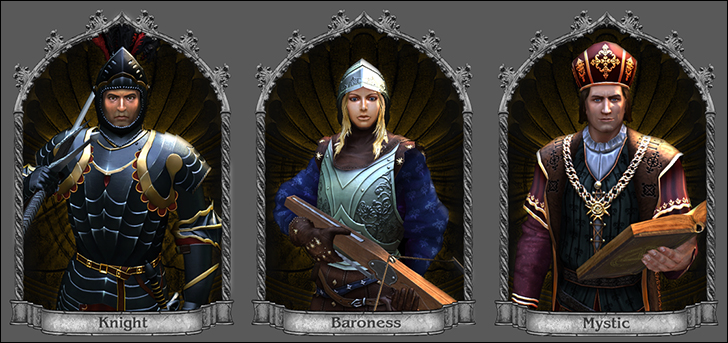
The three different heroes of Eisenwald.
Legends of Eisenwald is based on scenarios, or “legends” as they're called. They work the same as the kind of scenarios you would play in any strategy game. They all have an individual map with its own set of characters, stories and quests. As you start one of these legends, you will have to choose between three distinct heroes to serve as your avatar. There's the Knight, the big guy in heavy armor who excels at killing people with all sorts of close-range weaponry; the Baroness, a roguish noblewoman who prefers to shoot at things from a distance; and the Mystic, who I suppose is a sort of spellcaster (he is currently not available to play in the beta). Regarding the Mystic, I should perhaps clarify that the world of Eisenwald is very much a medieval world with very little magic besides the magic used in combat (which mostly consists of healing spells).
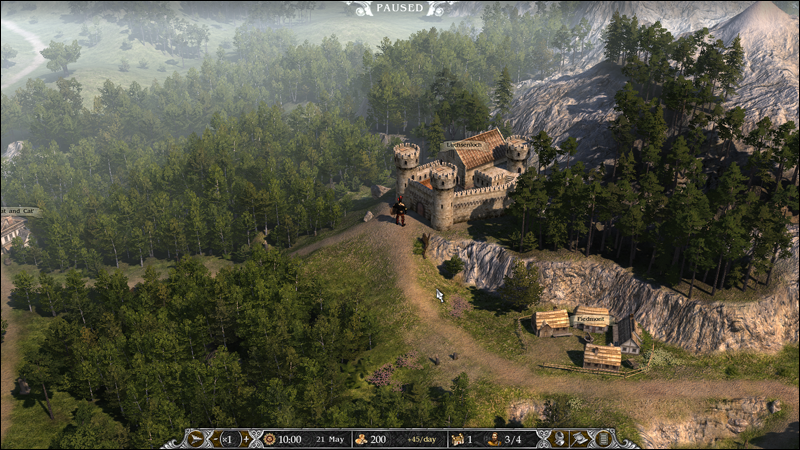
A lord and his castle.
You're not developing towns and you're not controlling several individual armies, as you do in strategy/RPG hybrids such as Heroes of Might & Magic or Age of Wonders. Instead, you focus on controlling a single band of adventurers led by your hero. Perhaps a likeness could be drawn to Mount & Blade in this regard. As you come across villages, churches and other locations, you will be able to recruit low tier units such as peasants or priests. Your followers, like in Mount & Blade, will gain experience in battle. With sufficient experience points, you will then be able to upgrade them. Peasants will become armored and blonde women will turn brunette. Your hero on the other hand, will instead be able to upgrade via skills chosen in a talent tree.
Another way to improve your hero and your hero's followers is to equip items. These items, such as weapons, armors, potions and trinkets, can be bought from merchants found in locations scattered all over the scenario map. You may also see some items drop from defeated enemies if you're lucky, or get them as quest rewards.
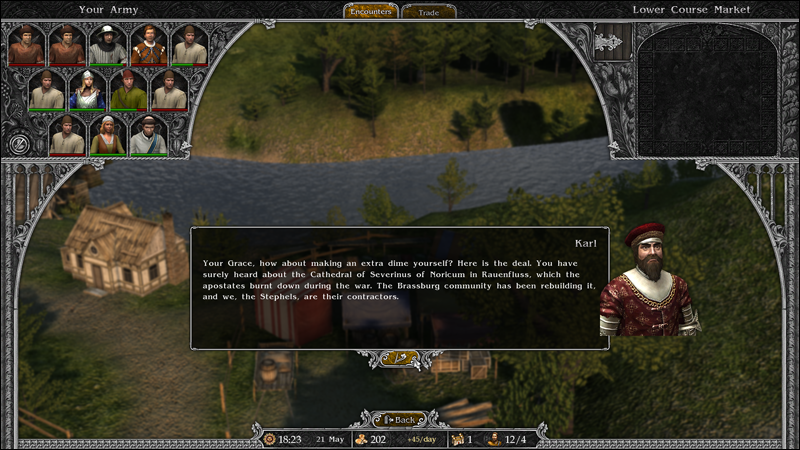
My main man Karl dropping some mad business on us.
The centerpiece locations on the scenario maps are the castles. The main stories in scenarios (judging from the beta and Aterdux' previous game Discord Times) seem to revolve around you and other noblemen and noblewomen, and your castles. In the beta scenario, a baron hosting a masquerade at his castle has gone missing. Of course, you are to investigate.
By owning castles, you will gain a certain amount of gold per day. Gold is your only resource, used for recruitment and items, and is therefor very important. Your castles may be attacked by bandits and rivaling noblemen (or whatever the scenario throws at you), and your only defence is your garrisoned units – and you don't control the battle unless you hero is present.
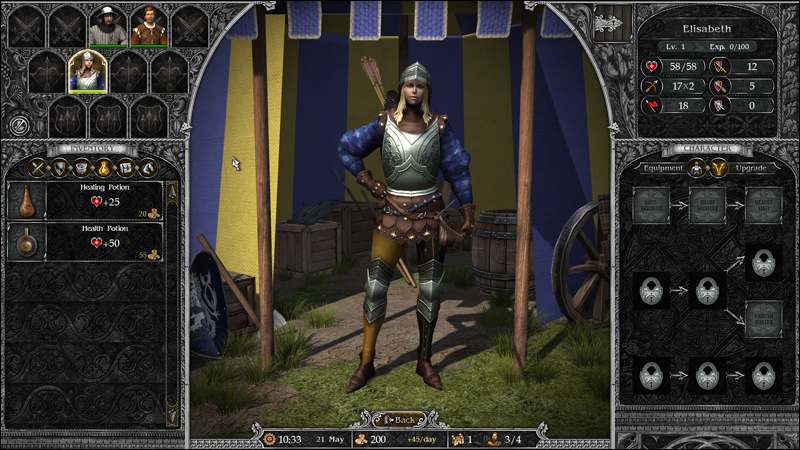
The party/character screen. Equip items, drink potions, or upgrade your skills.
Besides castles and towns, you'll come across taverns, mills, graveyards, bandit hideouts, smithys and more. However, these locations don't always offer anything of interest. In fact, some locations appear to be completely uneventful. Also, a tavern could for instance at one point offer little more than gossip, and at another point (later in the scenario) offer a quest. This could very well be because its a beta, but perhaps many of the locations are meant to be little more than scenery.
You will also come across NPCs wandering the map. Although these NPCs are rarely more than guards and patrols, they help make the world feel a little more alive. While the writing may not be the game's strongest point, the gossip in taverns and the NPC interactions can be quite funny, albeit a little silly at times.
Something I'm enjoying very much in Legends of Eisenwald is the music composed by Ressa Schwarzwald. It's made up of some very beautiful arrangements with flutes, strings, pipes, drums and what have you. Some of the games Eisenwald is often compared to are highly praised for their music, and I think Eisenwald is in a good place to reinforce the allege that “strategy-RPGs always has great music” (which is something I made up just now, but... it really should be a thing). The game seems to lack a bit of ambiance and world sounds, however.

An early fight in the beta scenario. The knife-wielding stabby-guy is about to drop the killing blow on the last enemy.
The combat of Eisenwald is initiative-driven and turn-based. This means that units will take their turns based on their unit type and equipment. For instance, a ranged combatant will act faster using a longbow than using a crossbow, but perhaps a knife-wielding rogue is faster than both.. Heavy armor also seems to burden the initiative of units. But it's important to note that movement is not affected. This is because every single turn in Eisenwald requires an action, and movement does not count as one. Your units are free to move as much as they need to perform their command. Whether it's moving one hex or moving across the entire battlefield – it doesn't matter.
So you can't choose to move somewhere and then end the turn without doing anything. Instead, you must choose a target to attack, and your unit will automatically move there and do so. That is, unless the path is blocked by another unit.
The only alternative to attacking, healing, buffing or performing some unit-specific action is to skip the unit's turn entirely. This rather simple approach doesn't mean that there is no tactics involved, or that you can just click wherever and be victorious. In fact, combat feels very volatile in that any one unit may suddenly mess things up completely, and your initial positioning of units and how you use them will greatly affect the outcome.
Attacking angles and positioning is important. Different types of units control the battlefield in different ways. Archers are obviously ranged attackers (and they really do pack a punch), but they can be somewhat disabled by having a melee fighter go up close and personal with them. They may still attack, but like any unit on the battlefield in close quarters with another, they are forced to focus on the close target. For an archer, this means that their ranged attack will be much less effective.
Your own hero is present on the battlefield and acts just like any other unit, except it's stronger. I think the Mystic, like the priest type of units, has more of a supporting role. But I'm not sure as the Mystic is unavailable to play in the beta.
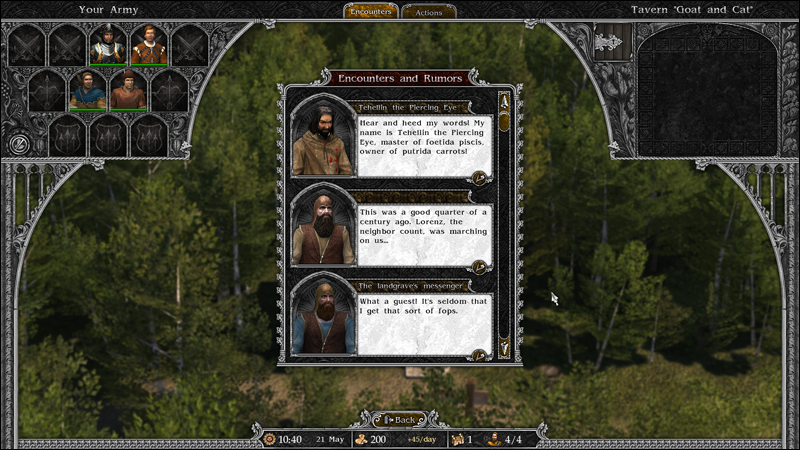
Gossip and hearsay at the local tavern.
My play-throughs of the beta were crash-free, and I experienced only a few bugs. The combat is fully functional in the closed beta, and is only really missing sounds. The map-view (or whatever you'd like to call it - the game outside of combat) could use some polish in terms of writing and direction for side-quests and objectives. The journal is helpful in that it updates with quest information, but the associated map is not yet fully functional. Well, I assume it's not, since locations and names are not showing. There is no spoken dialogue when your hero is interacting with NPCs, and I do not think there ever will be, but I feel at least reactionary sounds and greetings like in games such as Baldur's Gate could help bring Eisenwald's NPCs feel a bit more alive. Finally, the otherwise detailed interface could use some work because at this time, there are no tooltips for buttons and its lacking information on things like hero skills and unit upgrades. This is something I know Aterdux is working on, though.
Legend of Eisenwald is looking to shape up quite nicely. Aterdux is currently looking to release it sometime in early 2013.
Something interesting – nay, wonderful - happened back in March. It was like an oasis suddenly appeared in the barren lands of adventure games and traditional role-playing games. In a move that caused more than a small stir in the games industry, Tim Schaefer's Double Fine Adventure managed to raise over three million dollars via crowdfunding on Kickstarter. Shortly after that, Brian Fargo pretty much managed to repeat the feat with Wasteland 2, also raising over three millions (including PayPal donations – also thanks to RPG Codex, because we. are. the best.). Following these two crowdfunding successes, the year of 2012 has seen many industry veterans and developers of genre classics leap out of hiding for a chance to develop the games they have always really wanted to make... or to cash in on some easy money.
But not all of these early studio-based Kickstarter projects were looking to rake in millions of dollars. In fact, many of the more interesting games were very modest with their goals. This includes Legends of Eisenwald, a turn-based strategy-RPG currently being developed by the small Belarusian studio Aterdux Entertainment. Spearheaded by Alexander Dergay, this small outfit approached potential backers – donned in full medieval LARP clothing - and asked for $50,000 to aid the game's development. In the end they had managed to exceed their goal and landed on a not-too-shabby $83,577 (not counting PayPal and other donations).
Legends of Eisenwald, being an early adopter of the Kickstarter model, explored unknown territory with their campaign. When I asked Alexander Dergay how they prepared, he answered: “I think our success at Kickstarter was a combination of a lot of preparation and certainly a bit of luck.”
“Before our campaign on Kickstarter, we didn't know much about how it all worked and there was very little information available - no postmortems or other articles on how to do a campaign for a video game on Kickstarter.”
Like many other smaller studios, Aterdux had a hard time convincing publishers to work with them. “We talked to several publishers and the amount of material we had was not enough for them. It's understandable because we were a small and relatively unknown company.” Luckily for Aterdux, the backers of Kickstarter saw the potential of Eisenwald. “The material we had was enough to convince our backers at Kickstarter, and thanks to them we got funded and have now brought the game to the stage of beta testing.”
“The amount of material needed for a successful campaign is directly related to how well a company is known. A big and reputable name doesn't need to have a beta, or even an alpha version of the game. A well-prepared concept and just a little material is enough. But for lesser-known companies, more preparation work is needed.”
The effort Aterdux had to put into their Kickstarter campaign seems to have been worth it, though. Not only has their success given them exposure and funding for their game, but it may also have influenced business relations. “I have a suspicion that our investors were equally happy or relieved to see that they invested money in something other people liked, too.” Dergay says that Aterdux may look to crowdfunding again if they would face any troubles financing future games. But for now, they will stay busy working on Legends of Eisenwald.
A sneak peek at Eisenwald
After their successful crowdfunding campaign ending on the 22nd of May this year, the people at Aterdux have been busy as bees. The game was well on its way during the Kickstarter, having been in development for a couple of years already. It has now been running a closed beta for a few weeks. Granted, it's a very early closed beta with a few features missing, but it has the fundamental pieces in place and it's fully playable. This preview is based on a couple of play-throughs of the beta, which is about 2-3 hours long in total.

A very influential game: King's Bounty (1990)
So what exactly is Legends of Eisenwald? Well, it's a little challenging to describe. Vague comparisons could be drawn to games like Heroes of Might & Magic and the original King's Bounty because of how you traverse a “world map”, but the only fully comparable game would be the rather obscure Discord Times - Aterdux' earlier title from 2004 - which is very similar in concept but quite different in presentation and features. For instance, one of the big draws of Legends of Eisenwald is the 3D turn-based combat, something which in Discord Times wasn't nearly as elaborated.

The three different heroes of Eisenwald.
Legends of Eisenwald is based on scenarios, or “legends” as they're called. They work the same as the kind of scenarios you would play in any strategy game. They all have an individual map with its own set of characters, stories and quests. As you start one of these legends, you will have to choose between three distinct heroes to serve as your avatar. There's the Knight, the big guy in heavy armor who excels at killing people with all sorts of close-range weaponry; the Baroness, a roguish noblewoman who prefers to shoot at things from a distance; and the Mystic, who I suppose is a sort of spellcaster (he is currently not available to play in the beta). Regarding the Mystic, I should perhaps clarify that the world of Eisenwald is very much a medieval world with very little magic besides the magic used in combat (which mostly consists of healing spells).

A lord and his castle.
You're not developing towns and you're not controlling several individual armies, as you do in strategy/RPG hybrids such as Heroes of Might & Magic or Age of Wonders. Instead, you focus on controlling a single band of adventurers led by your hero. Perhaps a likeness could be drawn to Mount & Blade in this regard. As you come across villages, churches and other locations, you will be able to recruit low tier units such as peasants or priests. Your followers, like in Mount & Blade, will gain experience in battle. With sufficient experience points, you will then be able to upgrade them. Peasants will become armored and blonde women will turn brunette. Your hero on the other hand, will instead be able to upgrade via skills chosen in a talent tree.
Another way to improve your hero and your hero's followers is to equip items. These items, such as weapons, armors, potions and trinkets, can be bought from merchants found in locations scattered all over the scenario map. You may also see some items drop from defeated enemies if you're lucky, or get them as quest rewards.

My main man Karl dropping some mad business on us.
The centerpiece locations on the scenario maps are the castles. The main stories in scenarios (judging from the beta and Aterdux' previous game Discord Times) seem to revolve around you and other noblemen and noblewomen, and your castles. In the beta scenario, a baron hosting a masquerade at his castle has gone missing. Of course, you are to investigate.
By owning castles, you will gain a certain amount of gold per day. Gold is your only resource, used for recruitment and items, and is therefor very important. Your castles may be attacked by bandits and rivaling noblemen (or whatever the scenario throws at you), and your only defence is your garrisoned units – and you don't control the battle unless you hero is present.

The party/character screen. Equip items, drink potions, or upgrade your skills.
Besides castles and towns, you'll come across taverns, mills, graveyards, bandit hideouts, smithys and more. However, these locations don't always offer anything of interest. In fact, some locations appear to be completely uneventful. Also, a tavern could for instance at one point offer little more than gossip, and at another point (later in the scenario) offer a quest. This could very well be because its a beta, but perhaps many of the locations are meant to be little more than scenery.
You will also come across NPCs wandering the map. Although these NPCs are rarely more than guards and patrols, they help make the world feel a little more alive. While the writing may not be the game's strongest point, the gossip in taverns and the NPC interactions can be quite funny, albeit a little silly at times.
Something I'm enjoying very much in Legends of Eisenwald is the music composed by Ressa Schwarzwald. It's made up of some very beautiful arrangements with flutes, strings, pipes, drums and what have you. Some of the games Eisenwald is often compared to are highly praised for their music, and I think Eisenwald is in a good place to reinforce the allege that “strategy-RPGs always has great music” (which is something I made up just now, but... it really should be a thing). The game seems to lack a bit of ambiance and world sounds, however.

An early fight in the beta scenario. The knife-wielding stabby-guy is about to drop the killing blow on the last enemy.
The combat of Eisenwald is initiative-driven and turn-based. This means that units will take their turns based on their unit type and equipment. For instance, a ranged combatant will act faster using a longbow than using a crossbow, but perhaps a knife-wielding rogue is faster than both.. Heavy armor also seems to burden the initiative of units. But it's important to note that movement is not affected. This is because every single turn in Eisenwald requires an action, and movement does not count as one. Your units are free to move as much as they need to perform their command. Whether it's moving one hex or moving across the entire battlefield – it doesn't matter.
So you can't choose to move somewhere and then end the turn without doing anything. Instead, you must choose a target to attack, and your unit will automatically move there and do so. That is, unless the path is blocked by another unit.
The only alternative to attacking, healing, buffing or performing some unit-specific action is to skip the unit's turn entirely. This rather simple approach doesn't mean that there is no tactics involved, or that you can just click wherever and be victorious. In fact, combat feels very volatile in that any one unit may suddenly mess things up completely, and your initial positioning of units and how you use them will greatly affect the outcome.
Attacking angles and positioning is important. Different types of units control the battlefield in different ways. Archers are obviously ranged attackers (and they really do pack a punch), but they can be somewhat disabled by having a melee fighter go up close and personal with them. They may still attack, but like any unit on the battlefield in close quarters with another, they are forced to focus on the close target. For an archer, this means that their ranged attack will be much less effective.
Your own hero is present on the battlefield and acts just like any other unit, except it's stronger. I think the Mystic, like the priest type of units, has more of a supporting role. But I'm not sure as the Mystic is unavailable to play in the beta.

Gossip and hearsay at the local tavern.
My play-throughs of the beta were crash-free, and I experienced only a few bugs. The combat is fully functional in the closed beta, and is only really missing sounds. The map-view (or whatever you'd like to call it - the game outside of combat) could use some polish in terms of writing and direction for side-quests and objectives. The journal is helpful in that it updates with quest information, but the associated map is not yet fully functional. Well, I assume it's not, since locations and names are not showing. There is no spoken dialogue when your hero is interacting with NPCs, and I do not think there ever will be, but I feel at least reactionary sounds and greetings like in games such as Baldur's Gate could help bring Eisenwald's NPCs feel a bit more alive. Finally, the otherwise detailed interface could use some work because at this time, there are no tooltips for buttons and its lacking information on things like hero skills and unit upgrades. This is something I know Aterdux is working on, though.
Legend of Eisenwald is looking to shape up quite nicely. Aterdux is currently looking to release it sometime in early 2013.
There are 127 comments on RPG Codex Preview: A peek at Legends of Eisenwald











